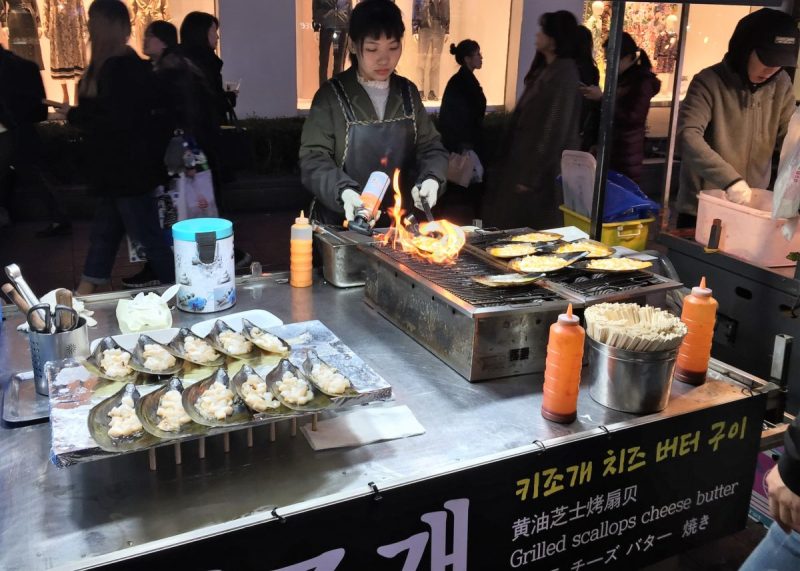Latest posts by Martin Moodie (see all)
- How I overcame Severe Tire Damage to become the oldest influencer in town - April 20, 2024
- Free as a (Kiwi) bird and flying high in Haikou - April 13, 2024
- Discovering Food Accademia’s world of fine flavours at a Hong Kong cha chaan teng - April 6, 2024

Thirty years on from my first visit here, I’m back at Lotte Hotel in Myeong-dong, Seoul, preparing for a week of interviews and store and airport visits.
In recent years I’ve tended to stay at the Grand Hyatt but this time I opted to return for reasons of convenience to my old haunt at the Lotte Hotel. It’s handy to be able to simply wander out of the hotel, turn right, wander a few metres and walk into Lotte Duty Free’s Star Avenue, the pioneering Hallyu (Korean wave) marketing concept that proved the trailblazer for so many exhilarating campaigns that have followed since.




You know that you’ve entered a duty free heartland almost from the moment you land at Incheon International Airport. Big signs promoting Lotte Duty Free loom over the arrivals baggage zone. Doota Duty Free flyers are given out when you buy a bus ticket to the city hotels. Every seatback on the buses carries a Korean Air SkyShop magazine (featuring, I am pleased to say, The Moodie Davitt Report logo on the front cover).


Back in 1989, I was a raw recruit to both travel retail and Korean culture. I remember wandering the streets wide-eyed, bedazzled and beguiled by the sights, smells and colours of the Seoul streets. The downtown duty free industry, which had only begun nine years earlier with the opening of Lotte Duty Free’s store next door to the hotel, was still in its infancy, driven almost entirely by a mix of Korean and Japanese customers. Chinese visitors were not even on the horizon. But already, the duty free sector had won a reputation for innovation, blue-chip brand dominance and intense competitiveness between Korean customers.




Three decades on, the Seoul streets remain a feast of the senses. But while the duty free trade is still synonymous with those traits I mentioned, it’s now a very different market landscape. Where once the Japanese dominated the international spend, now it’s all about the Chinese – worth well over 70% of total sales for most duty free retailers. Much of that revenue since March 2017 (the beginning of the THAAD row with China) has been driven by daigou trade, the phenomenon of Chinese shuttle traders as they like to call them here, buying Korean and international brands (particularly beauty products) in vast quantities, repacking them (and turning Incheon International Airport into a near rubbish-tip in places) for onboard storage and then reselling them in China.
The question on everyone’s lips here – and internationally – is how much China’s new e-commerce law introduced on 1 January (in large, designed to curb if not eradicate daigou trade worldwide) will affect Korean duty free. No-one – neither retailers, brands nor analysts – really knows the answer yet. Most brands have shown growth in Korean duty free during the first two months of 2019, but some fashion and accessory houses have posted sharp year-on-year drops. Everyone is monitoring the situation here closely, while watching to see exactly how judiciously Chinese customs officials police travellers returning from South Korea and Japan.
One of the other big concerns here is an expected further proliferation of duty free licences as the government seeks to slice up what it perceives to be a fast-expanding cake into more pieces. But this is not about baking a cake. In fact, the whole idea is half-baked. One of the many problems with such policies, as with a similar flurry of licence additions in 2015/16, is that they are based on the distinctly shaky premise that the market will continue to grow, while encouraging cut-throat competition among established and emergent retailers. The Moodie Davitt Report has spoken out repeatedly, including at a Korean National Assembly hearing in February 2016, against the short-sightedness of such an approach.

Historical context helps here. It’s all too reminiscent of the then-booming but Japanese-dominated Korean duty free market of 1984-1988. In that period Japanese arrivals rose by +94%, earning the duty free industry the sobriquet of ‘the goose that lays the golden eggs’. A proliferation of licences led to 29 stores being opened, far in excess of necessary capacity. When the Japanese bubble economy burst in 1990, many shops were forced to close as tourist arrivals and spending slumped. The golden egg had cracked.
In an interview with Seoul’s highly influential Chosun Daily in January 2017, I noted: “The proliferation of duty free licences in Korea was based on the perception that it is an industry full of easy and rich pickings. The reality is that excessive competition in the market has simply driven up the cost of business (especially with tour agency commissions) and left too many players fighting over a pot that is frighteningly vulnerable to a downturn in Chinese tourism.”
I was proven right, though at top-line level the Korean duty free trade grew strongly last year (+35%), driven by the frenzied level of daigou trading.
Now, just as the Chinese government is seeking to crack down on, perhaps eliminate, daigou trading, there is the likelihood of more duty free licences here. Really? If that happens, Korea’s duty free chickens will have come home to roost. But they won’t be laying any golden eggs.



